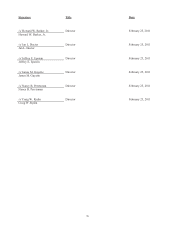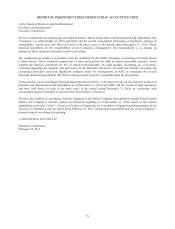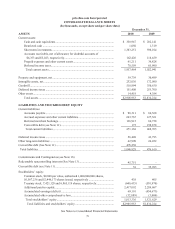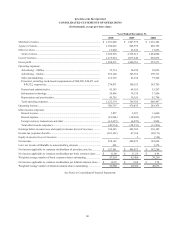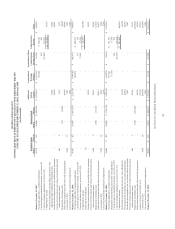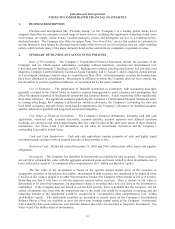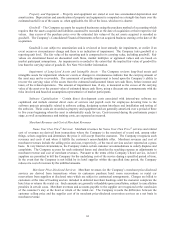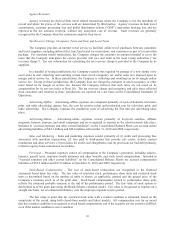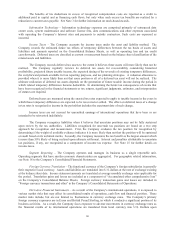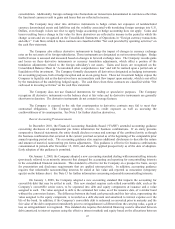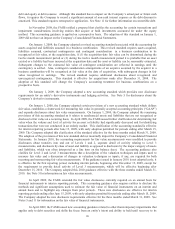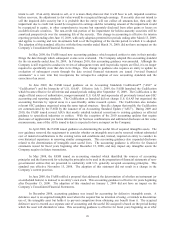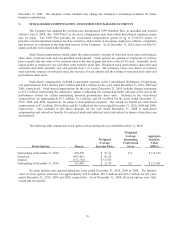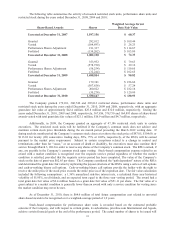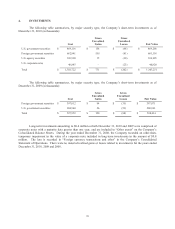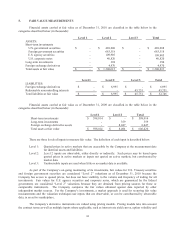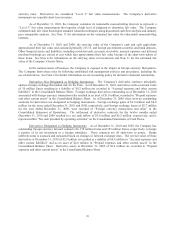Priceline 2010 Annual Report Download - page 160
Download and view the complete annual report
Please find page 160 of the 2010 Priceline annual report below. You can navigate through the pages in the report by either clicking on the pages listed below, or by using the keyword search tool below to find specific information within the annual report.86
The benefits of tax deductions in excess of recognized compensation costs are reported as a credit to
additional paid in capital and as financing cash flows, but only when such excess tax benefits are realized by a
reduction to current taxes payable. See Note 3 for further information on stock-based awards.
Information Technology – Information technology expenses are comprised primarily of outsourced data
center costs, system maintenance and software license fees, data communications and other expenses associated
with operating the Company’s Internet sites and payments to outside contractors. Such costs are expensed as
incurred.
Income Taxes – The Company accounts for income taxes under the asset and liability method. The
Company records the estimated future tax effects of temporary differences between the tax bases of assets and
liabilities and amounts reported on the Consolidated Balance Sheets, as well as operating loss and tax credit
carryforwards. Deferred taxes are classified as current or noncurrent based on the balance sheet classification of the
related assets and liabilities.
The Company records deferred tax assets to the extent it believes these assets will more likely than not be
realized. The Company regularly reviews its deferred tax assets for recoverability considering historical
profitability, projected future taxable income, the expected timing of the reversals of existing temporary differences,
the carryforward periods available for tax reporting purposes, and tax planning strategies. A valuation allowance is
provided when it is more likely than not that some portion or all of a deferred tax asset will not be realized. The
ultimate realization of deferred tax assets depends on the generation of future taxable income during the period in
which related temporary differences become deductible. In determining the future tax consequences of events that
have been recognized in the financial statements or tax returns, significant judgments, estimates, and interpretation
of statutes are required.
Deferred taxes are measured using the enacted tax rates expected to apply to taxable income in the years in
which those temporary differences are expected to be recovered or settled. The effect on deferred taxes of a change
in tax rates is recognized in income in the period that includes the enactment date of such change.
Income taxes are not accrued for unremitted earnings of international operations that have been or are
intended to be reinvested indefinitely.
The Company recognizes liabilities when it believes that uncertain positions may not be fully sustained
upon review by the tax authorities. Liabilities recognized for uncertain tax positions are based on a two step
approach for recognition and measurement. First, the Company evaluates the tax position for recognition by
determining if the weight of available evidence indicates it is more likely than not that the position will be sustained
on audit based on its technical merits. Secondly, the Company measures the tax benefit as the largest amount which
is more than 50% likely of being realized upon ultimate settlement. Interest and penalties attributable to uncertain
tax positions, if any, are recognized as a component of income tax expense. See Note 15 for further details on
income taxes.
Segment Reporting – The Company operates and manages its business as a single reportable unit.
Operating segments that have similar economic characteristics are aggregated. For geographic related information,
see Note 18 to the Company’s Consolidated Financial Statements.
Foreign Currency Translation – The functional currency of the Company’s foreign subsidiaries is generally
their respective local currency. Assets and liabilities are translated into U.S. dollars at the rate of exchange existing
at the balance sheet date. Income statement amounts are translated at average monthly exchange rates applicable for
the period. Translation gains and losses are included as a component of “Accumulated other comprehensive loss”
on the Company’s Consolidated Balance Sheets. Foreign currency transaction gains and losses are included in
“Foreign currency transactions and other” in the Company’s Consolidated Statements of Operations.
Derivative Financial Instruments – As a result of the Company’s international operations, it is exposed to
various market risks that may affect its consolidated results of operations, cash flow and financial position. These
market risks include, but are not limited to, fluctuations in currency exchange rates. The Company’s primary
foreign currency exposures are in Euros and British Pound Sterling, in which it conducts a significant portion of its
business activities. As a result, the Company faces exposure to adverse movements in currency exchange rates as
the financial results of its international operations are translated from local currency into U.S. Dollars upon


